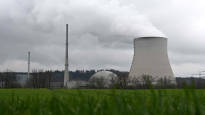The nuclear waste will eventually be buried deep in the rock. The exact final disposal location has not yet been chosen in Germany.
In Germany, the last three nuclear power plants will stop producing electricity today. But how do you shut down a large nuclear power plant?
At the Isar 2 power plant near Munich, the shutdown process will begin at 10:00 p.m. local time.
– We are starting to reduce the plant’s electricity production by ten megawatts per minute, says the head of the power plant Carsten Mueller for Bild newspaper.
The shutdown will continue until the reactor’s electricity production has dropped to around 30 percent.
– In this case, we stop supplying electricity to the high-voltage network and the generator is automatically disconnected from the network, Mueller describes.
A similar process is carried out in northwestern Germany for the Emsland nuclear power plant and the Neckarwestheim 2 power plant in the southwestern part of the country.
The latter of these has been operating at 70 percent capacity since mid-January, says the director of the atomic energy department of the EnBW company that manages the power plant Jörg Michel.
According to him, stopping the nuclear power plant is a “routine measure”, which is often done, for example, in connection with inspections.
– The extraordinary thing is that now it will be done for the last time, Michel commented to the news agency AFP.
When the reactor slows down, it no longer pushes hot water into the turbines, which stop and at the same time stop producing electricity.
During the following days, the chain reaction of atoms maintained by the fuel rods stops and the fuel cycle begins to cool, Jörg Michel of the EnBW company describes the last moments of the power plants.
Dismantling takes 15 years
The dismantling of the now closed Neckarwestheim 2 nuclear power plant will begin next year.
The power plant’s reactor has 193 fuel rods. In the first step, these highly radioactive elements are moved to an adjacent building and immersed in a pool filled with water.
The fuel remains underwater for three to five years, after which they are encased for temporary storage.
The dismantling of Germany’s last three nuclear power plants is estimated to take about 15 years.
Germany has decided to bury radioactive waste deep underground. However, a suitable final disposal site has not yet been found.
The authority responsible for the matter estimated last year that it could take decades to find a place. The actual construction of the disposal site will take an estimated twenty years.
Roughly, this means that the most environmentally dangerous nuclear waste – with high radioactivity – will not be buried permanently in Germany until the end of the current century.
Instead, a disposal site for the lower radioactivity waste has already been found in the central parts of the country, in an abandoned iron mine near Salzgitter.
This investment site is scheduled to be completed in 2027.
Also listen to the Uutispodcast episode on the subject:
Source: AFP
